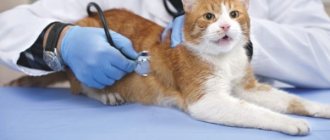Reasons for the drop in temperature
Most often, a decrease in an animal’s body temperature occurs as a result of hypothermia. In this sense, the situation is especially dangerous for animals when it is very humid outside. Then the wool is saturated with moisture. The air that circulated between the fur and skin disappears. The air acted as a kind of buffer between the pet’s skin and the cold surrounding air and prevented the animal from freezing.
Small kittens and older animals are more susceptible to hypothermia, that is, those categories that cannot maintain normal body temperature for a long time under unfavorable conditions.
In addition to unfavorable environmental factors, various pathological conditions can also lead to a decrease in an animal’s body temperature. For example, prolonged malnutrition and exhaustion one of the symptoms is low temperature. At the same time, the animal is emaciated and inactive.
Older cats suffering from severe liver and kidney disease may have low body temperature as one of their symptoms.
Bleeding, especially massive bleeding, causes a decrease in the animal’s body temperature. External bleeding is obvious. Arterial bleeding is especially dangerous. In this case, the animal quickly dies without assistance. Internal bleeding can be noticed by the appearance of blood in the urine or stool.
Diseases of the heart and blood vessels can cause a decrease in a cat’s body temperature. Symptoms depend on the specific disease. This can be a variety of arrhythmias, shortness of breath, deterioration in the pet’s general condition, and blue discoloration of visible mucous membranes.
Viral infections that occur with suppression of the immune system may occur with a decrease in the animal’s body temperature, instead of the usual fever. An oncological process can lead to a decrease in body temperature.
Nervous diseases in cats may be accompanied by a decrease in body temperature. At the same time, the animal's behavior changes. We're not talking about games.
Signs of a low temperature
Changes in the animal’s body will depend on the degree of temperature decrease and may become irreversible and even lethal. The first signs of a decrease in temperature are:
- cold shivering;
- lethargy and apathy;
- blanching of visible mucous membranes;
- the animal lies down in the warmest places.
If an animal's body temperature drops to 36 ° C, metabolism is seriously inhibited. If you place your hand on the cat's body in the abdomen (where there is less hair), you can feel the coolness. Normally, a cat's body temperature is higher than that of a human and the animal seems hot.
During this period, serious changes occur in the cat’s body:
- bradycardia develops (heart rhythm becomes slower);
- breathing becomes shallow, the number of respiratory movements decreases;
- peristalsis slows down;
- diuresis decreases;
We recommend reading: Types of Worms in Cats that are Dangerous to Humans
The animal becomes sleepy and even falls into lethargy. If help is not provided, the animal falls into a coma and dies.
Treatment
If your pet is shivering and huddling close to the heaters, he is most likely freezing. A frozen cat needs to be warmed up. If an animal freezes outside, it must be brought into a warm room, wrapped in a warm blanket and placed in a place where there are no drafts. If the cat has mild hypothermia, passive rewarming will be sufficient. If the animal has wet fur, it needs to be dried. You can use a hairdryer. When the animal warms up a little, stops shivering, its body temperature rises to 37.2°C, you can offer it a warm drink and some food.
With prolonged exposure to the cold and severe hypothermia, these measures will not be enough. It is better to take the animal to the veterinarian. It needs to be warmed up along the way. You need to wrap the cat in a warm blanket, you can use heating pads. In this case, at the veterinary clinic the animal will be given a warm enema and placed on a drip with a slightly warmed solution. For any degree of hypothermia, the animal must be shown to a doctor. Because hypothermia can lead to inflammation in the kidneys or membranes of the brain, pneumonia and other diseases can develop.
If there is no hypothermia, but the animal’s body temperature drops, it should be wrapped in a warm blanket, covered with heating pads if necessary, and taken to a doctor for examination.
First aid
If you find a freezing animal on the street, first of all bring it into a warm room . At home, wrap your pet in a wool blanket or any other item. Be sure to place the cat on a heating pad or cover it with them. Give warm milk or broth. If the animal does not refuse food, feed it. This will help restore energy reserves in the body and normalize metabolism.
Normal temperature in cats and kittens
Indicators of normal temperature in an animal are formed due to the work of internal organs: the nervous system, pituitary gland, hypothalamus. The study of the totality of all processes affecting indicators continues today.
A cat's normal temperature is in the range of 37.5° - 39°C. This spread is indicated due to the fact that nature has provided an individual indicator for each cat. For some cats it is 38.5 degrees, and for another it is 39 degrees.
In the morning, the values are usually somewhat underestimated, while in the evening, especially after active pastime, the values may be higher. Also, the indicators depend on the size of the animal: large individuals have lower temperature indicators than small cats.
A small kitten has a higher temperature than an adult cat. This can be explained by the high mobility of kittens.
Body temperature of Sphynx cats
The temperature regime of bald graceful sphinxes does not exceed normal values. There is a misconception that creatures exposed by nature and selection warm the air around them with a body temperature of 42 degrees. Yes, the skin feels excessively hot to the touch, but this is only due to the tactile sensation in the absence of fur.
Fever and chills in cats: treatment features
In cats, like in other animals, with any ailment, the temperature rises or falls. This is the first signal that your pet needs immediate help. The cat tolerates any temperature deviation from the norm very poorly. As a rule, the animal does not eat or drink anything and lies quietly in a secluded place. What to do if your cat’s temperature rises or falls, and why can this happen? Let's talk about this now.
Reducing the temperature correctly
We recommend reading: How to Groom a Corella
Stabilizing the temperature of cats
Video “Cat sneezes”
Comments and Reviews
How to take a cat's temperature
Not all owners know how to correctly measure a cat's body temperature. It's actually easy to do. For this you need a thermometer, and it is better if it is an item only for the use of the animal. Purchase a thermometer at a pharmacy.
Temperatures are measured with a mercury thermometer, an electronic universal thermometer, or an electronic rectal thermometer. Electronic products provide results faster and are more convenient to use.
Since the temperature of animals is measured in the rectum, it should be understood that you will have to act against the cat’s wishes. Often, the procedure requires the help of members of the household. The cat is secured with a towel or any fabric - you need to hide the paws by wrapping the pet in a “cocoon”. You can simply hold the cat by the paws with one person, holding the head by the scruff of the neck, while another person takes the measurement.
Before inserting the thermometer into the rectum, its tip should be lubricated with Vaseline. If the thermometer is mercury, hold it for no more than 5 minutes.
After the procedure, the thermometer is disinfected with any means.
Help from professionals
If your mustachioed pet shows signs of hypothermia, contact our clinic immediately. Experienced specialists use modern medical equipment, accept patients as inpatients or come to your home at any time of the day. We will do everything possible to restore your cat's health and good mood.
First aid should be aimed at increasing the animal’s body temperature. The cat must be covered with hot water bottles. If this does not help, the pet should be taken to a veterinary hospital immediately.
Treatment of fever in a cat
Neither hypothermia nor hyperthermia should be ignored. As stated above, there are serious reasons for a decrease or increase in temperature that must be found and eliminated. It is better to consult a veterinarian: you may need to conduct an examination and undergo tests.
How to increase the temperature
A frozen and shivering cat is brought into a warm room. The wet fur is dried with a hairdryer.
A kitten with hypothermia urgently needs to be warmed in any way: a blanket and heating pads will do. You can simply hold your baby close and wrap yourself up with him. An adult cat also needs warmth. Be sure to offer warm drink and food after the animal stops shaking.
If the low temperature lasts for a long time or the indicators have dropped significantly, the animal should be taken to a veterinary clinic rather than trying to treat the cat at home.
How to reduce a cat's fever
With a slight increase in body temperature, cats do not fuss and do not knock it down. But a significant increase signals that it’s time to intervene. High values on the thermometer threaten the cat's body with dehydration, which is fraught with the worst consequences.
There are several tips to help reduce your cat's fever:
- the wool is slightly moistened;
- Ice is applied to the neck and inner thighs;
- Give the cat a cool drink.
If there is no decrease, the animal is shown to a specialist.
How to help a cat with a high temperature
Treatment methods for a cat with a high fever depend on the diagnosis and the extent of the disease. Since a high temperature can be a sign of a disease, the main treatment is aimed at eliminating the inflammatory focus in the body. Most often, when antibiotics are prescribed, the body temperature returns to normal.
In general, high temperature in itself is not dangerous. After all, with its help, the animal’s body tries to fight the virus on its own. Reducing the temperature with the help of antipyretic drugs is necessary in case of very high temperatures, which can provoke convulsions in the animal.
If the temperature is not very high, then you can try to bring it down at home. To do this, you need to moisten a towel or gauze with cold water and wrap the animal for about ten minutes. As the fabric dries, the cat's body temperature will noticeably decrease. Such manipulations are very effective in increasing body temperature from overheating of a pet outside in hot weather.
The same quick effect can be achieved by using ice from the refrigerator. Wrap the pieces of ice in gauze and place them on the cat's neck and inner thighs. In this case, you should give her something to drink more often. To prevent dehydration, it is recommended to give your pet pharmaceutical rehydron.
Only a specialist can prescribe comprehensive treatment for a cat after a thorough examination. If the temperature does not decrease even after taking antibiotics, the doctor will prescribe an additional study to identify the causes of hyperthermia.
It should be noted that a low temperature in an animal also indicates an existing pathology in the body. The cause of low temperature may be blood loss or hypothermia. Sometimes this temperature is observed in cats with chronic diseases of the kidneys and endocrine system. Help in these cases is to warm the pet using a warm heating pad. If your cat's body temperature persists for a long time, you should consult a specialist.
Since high temperature is a consequence of a disease, preventive measures are aimed at avoiding them by observing hygiene standards, rational nutrition and proper care of the animal.
It is known that the normal temperature in cats is determined by the range from 37.5 to 39 degrees. In this case, in animals of one breed a certain body temperature will be considered normal, while in cats of another breed the same temperature will signal pathology. Kittens, as a rule, normally have a slightly higher body temperature than an adult cat. Any significant deviation from the norm in temperature indicators confirms that there are problems with the pet’s health.
Low temperature in a cat - causes and what to do
We all love our pets and worry when something is wrong with them. One of the symptoms of serious illness in an animal may be low body temperature. The thermoregulation center is located in the brain, or more precisely in one of the parts of the medulla oblongata (hypothalamus).
The normal body temperature of an adult cat is recorded in the range of 37.8 – 39.2 °C, in kittens – from 38.3 to 39.7 °C.
The scientific name for a condition characterized by a drop in body temperature is hypothermia.
There are three stages of the disease:
- Mild (body temperature 32 – 35°C);
- Moderate (temperature drops to 28 – 32°C);
- Deep (body temperature below 28°C).
A decrease in body temperature leads to centralization of blood circulation. Blood rushes to the brain and heart, protecting them first, and peripheral blood flow decreases at this time. Metabolic processes slow down and the body's defense mechanisms turn on (muscle tremors, fur fluffs up, breathing slows down).
The acid-base ratio in the blood changes, hypercapnia develops (increased carbon dioxide content), then interstitial and interstitial fluid rushes into the alveoli. In this case, the process of cellular respiration is disrupted, and the supply of oxygen to the tissues is insufficient. Against the background of pathological processes occurring in the body, blood clotting is impaired and pulmonary edema develops.
Causes of hypothermia
There are many reasons for hypothermia:
- Hypothermia. A common cause for cats that walk outside. The temperature decreases due to the physical transfer of heat to the external environment. Frostbite can be an additional problem.
- Infectious or viral disease. There are two possible developments. The first option is a slowdown in metabolism (as a result of intoxication). The second option is inflammation of the brain, hypothalamus (responsible for temperature). Often accompanied by symptoms such as diarrhea, cough, shortness of breath.
- Low blood pressure. Because of this, the oxygen supply to tissues deteriorates. As a result, metabolism slows down and temperature drops. A decrease in pressure is easily determined by a tonometer.
- Starvation. Because of it, metabolism slows down and temperature decreases. With severe exhaustion, other symptoms appear: cardiovascular disorders, alopecia, weight loss, and in severe cases, atrophy of internal organs and muscles.
- Anesthesia. Because of it, the temperature drops, as the brain turns off, along with the hypothalamus and the thermoregulation center. After the animal comes to its senses, the symptoms disappear, but with deep and long-term anesthesia, medical assistance will be required.
- Cancer. Because of this, the main part of the nutrients goes not to healthy cells, but to tumor cells. Due to a deficiency of substances, metabolism and temperature drop. More often, such signs appear in the later stages, when the main problem is not hypothermia, but metastases.
- Kidney diseases. Intoxication leads to metabolic disorders and a decrease in temperature. Often the disease is accompanied by problems with the liver, urination, and cardiovascular system.
- Heavy bleeding. As a result, blood pressure drops, oxygen supply to tissues deteriorates, metabolism slows down, and temperature drops. Additional signs are anemia and bleeding itself.
- Metabolic disorders. It becomes a consequence of a deficiency of various vitamins, amino acids, fats and minerals. Alopecia, stunted growth, curvature of bones, and cardiovascular disorders are often added to the symptoms.
- Vitamin deficiency. As a result, metabolism is disrupted. This leads to a decrease in metabolism. Additional symptoms include alopecia, curvature of bones, digestive and urinary problems.
- Poisoning. They lead to a wide variety of consequences. Often accompanied by diarrhea, vomiting, cardiovascular and respiratory disorders, and pathologies of the nervous system.
- Dehydration. The decline begins with severe dehydration, when blood pressure drops. Additional symptoms are dry mucous membranes, sunken eyes, lack of shine in the coat, and weakness.
- Heart diseases. Because of them, blood circulation is disrupted and the supply of oxygen to tissues is reduced. This is often accompanied by low blood pressure, chest pain, swelling, and blue discoloration of the mucous membranes.
- Enteritis. The temperature drops in severe cases, when the integrity and function of the intestine is severely impaired, cardiovascular pathologies, intoxication, and dehydration appear.
- Diseases of the nervous system. Hypothermia appears if the hypothalamus and thermoregulation center are involved in the pathological process. Often accompanied by a variety of abnormalities in the functioning of the central nervous system.
This is interesting: The cat has a temperature of 40
Specialized assistance
The best solution when identifying signs of hypothermia in a pet is to contact a veterinarian. It is necessary to find out the cause of the disease in an animal rescued from the street and in your cat, and carry out a number of diagnostic measures:
- Examination by a specialist.
- Collection of tests.
- X-ray of the chest and abdominal organs.
- Ultrasound examination of the abdominal organs.
- X-ray of skeletal bones.
Depending on the severity of the condition, when examining the animal, the doctor will detect a decrease in heart rate, an irregular heart rhythm, a decrease in blood pressure, a decrease in the amount of urine excreted, changes in breathing - it becomes superficial and rare. The animal reacts sluggishly or not at all to inspection; consciousness may be absent.
In severe cases, breathing practically stops, single breaths appear, foam may appear at the mouth (a sign of pulmonary edema), lack of consciousness, pulse and blood pressure may be barely noticeable or not detectable.
The doctor prescribes intravenous infusions with warm solutions, medications that relieve symptoms of the underlying disease, and oxygen therapy. The clinic staff constantly monitors the cat’s vital signs.
For more severe hypothermia, internal warming is performed: the stomach is washed with warm solutions, enemas with heated solutions, and inhalation of warm air.
In case of clinical death, the animal begins to be resuscitated immediately. If the measures are not successful, the death of the animal can be declared if the body temperature is above 30 – 32°C. Surviving patients, especially old ones, may have consequences in the form of impaired brain function, a shift in the point of thermoregulation, and cardiovascular failure. Some experts believe that animals that have experienced severe hypothermia are more likely to experience repeated episodes of hypothermia.
Hypothermia Treatment Methods
First aid should be aimed at increasing the animal’s body temperature. The cat must be covered with hot water bottles. If this does not help, the pet should be taken to a veterinary hospital immediately.
The doctor will take the following measures:
- examine the patient;
- will administer intravenous infusion with warm solutions;
- relieves the symptoms of the disease that led to hypothermia;
- prescribe oxygen therapy;
- will carry out constant monitoring of body temperature until the animal’s condition stabilizes.
Low temperature in a cat
A cat, like a person or dog, has a normal temperature. Only in the mustachioed pet it is significantly higher than in humans.
So, for an adult cat the norm is 37.8-39.2 degrees, and for a young animal 38.3-39.7 degrees. However, a cat may have a low or high temperature.
Today we will talk specifically about low body temperature, which is also called hypothermia. It is typical mainly for small kittens and older individuals.
Experts divide hypothermia into 3 types:
- mild – body temperature fluctuates between 32-35 degrees;
- moderate – 28-32;
- deep - below 28 degrees.
© shutterstock
Main causes of low temperature
In most cases, a cat develops a low temperature due to hypothermia. But this is not the only reason. An animal may also suffer from hypothermia for other reasons. There are the following causes of low temperature in a cat:
- Peculiar infections and viruses that provoke low temperature because they destroy the pet’s immunity.
- General malaise and weakened body.
- Loss of appetite and weight loss.
- Consequences of anesthesia.
- Malignant tumors.
- Kidney disease, which occurs mainly in old age;
- Various injuries.
- Violation of metabolic processes. This happens due to a lack of a number of different vitamins and nutrients in the body. Symptoms of this type of disorder are: hair loss, slow growth, deformation of limbs, deterioration of claws, low temperature.
- Consequences after poisoning.
- Dehydration. After the body loses 10% of water, severe pathological changes occur. The following signs indicate that your cat does not have enough water: general weakness, dry mucous membranes - the mouth, nose and conjunctiva, as well as sunken eyeballs, low temperature.
- Enteritis is the general name for diseases that are characterized by inflammation of the intestinal epithelium. Most often, this disease occurs in young kittens, but it is also dangerous for adults if they have poor nutrition, terrible living conditions, or have experienced some kind of stress. In addition, the virus of this disease leaves the body along with feces and poses a threat to surrounding pets.
- Severe bleeding, both internal and external. Of course, external bleeding is easy to notice, but the presence of internal bleeding can only be guessed by stool or urine.
- Heart diseases. The symptoms of this type of disease directly depend on the type of disease. A mustachioed pet may exhibit arrhythmia, shortness of breath, or blue discoloration of the mucous membranes, and low temperature.
- Disease of the nervous system. In this case, the behavior of the animal changes radically. It becomes completely indifferent to various games and amusements.
© shutterstock
Symptoms that indicate hypothermia
A sign that a cat has a low temperature may be unusual behavior of the animal. A low temperature in an animal is characterized by:
- trembling of the whole body;
- loss of mood, the mustachioed pet is very lethargic;
- the cat is looking for a warm place;
- wool rises;
- breathing slows down;
- The heart rhythm is also disturbed.
How to normalize an animal's temperature
If your pet suffers from low body temperature, then it is necessary, first of all, to warm it up. To do this you should:
- if the cat is outside, bring it into the house;
- if the animal gets wet from rain or snow, it is dried with a hairdryer and wrapped in a towel;
- wrap in a warm blanket and place a heating pad on it, heated to 39 degrees;
- the mustachioed pet is given warm milk or warm broth;
- periodically measure the temperature, it must be under control;
- if the temperature begins to return to normal, then the cat needs to be fed a little.
When normal internal temperature in cats is not restored, you should definitely call a doctor or take your pet to him.
© shutterstock
Take the cat to the clinic immediately if its temperature drops to 36 degrees and continues to drop rapidly.
The veterinarian will carry out a full examination of the animal and will be sure to correctly diagnose the cause of the low temperature, and will also help treat your pet.
The veterinary clinic can:
- Give your pet a warm enema.
- Place a dropper with a warming solution.
Undesirable effects of hypothermia
Hypothermia should not be taken too lightly. With prolonged low temperatures, a cat may experience such undesirable consequences as:
- inflammation of the membranes of the brain;
- pneumonia;
- kidney disease.
As you can see, a low temperature in a cat, like any other disease, requires special care for the animal. Therefore, if you find the above symptoms, you should definitely consult a doctor. Such a seemingly simple disease should not be left to chance, otherwise it can even lead to the death of the animal.
Fever
The normal temperature for a cat is considered to be 38-39.2 degrees Celsius. An increase in this indicator by a degree or more already indicates that the pet is unwell. The first symptom of the onset of the disease can be called lethargy and when the pet does not eat anything for a long time. Also, the cat may constantly lie down and refuse any communication. Although, there are cases when the symptoms are the opposite - the pet, on the contrary, is overly active, has increased thirst and eats constantly.
High fever in cats can also provoke symptoms such as vomiting, dilated pupils, constipation, irregular pulse and breathing. There may also be discharge from the ears, eyes and nose. In most cases, an elevated temperature in a cat causes only a couple of symptoms. A sick animal's fur often becomes dull and bristles in different directions.
When signs of fever appear in a cat, it is necessary to carry out an examination in order to quickly understand its cause. It’s worth starting with the fur and seeing if there is any discharge from the animal’s nose. You also need to look into the oral cavity. In a healthy cat, it is pale pink, there is no stomatitis or ulcers. Feeling the abdomen will help determine the condition of the gastrointestinal tract. After all, it is precisely because of such diseases that a sick pet does not eat anything.
We measure the temperature
A cat's fever can be measured using a rectal thermometer. If this is not the case, you can use the usual one. It will be more convenient if the animal is standing, but you can measure the heat of a sitting or lying cat. Next, you need to lubricate the tip of the thermometer with Vaseline or ordinary oil. Then lift the furry tail and carefully insert it into the rectum about three centimeters. For more information on this procedure, see the video below.
In a couple of minutes you can get exact numbers. The kitten's temperature is 40 degrees, what should I do? Try to find out what the reason is, although in any case you will have to take him to a specialist. When a cat’s fever rises to 40 degrees, postponing a trip to the veterinarian is dangerous. Thus, high temperatures negatively affect the pet’s health, causing problems such as dehydration or cerebral edema.
Reducing the temperature correctly
You should not try to reduce a fever of 40 degrees or higher at home with antipyretic drugs intended for humans. Only in the most extreme cases, if the veterinarian does not arrive soon, and the cat’s high temperature has risen above 40 degrees, is the pet given Analgin. However, the best way to reduce the fever is through physical methods, such as placing ice on your inner thighs or neck. Alternatively, you can wrap your pet in wet gauze.
The most correct decision when a cat’s temperature rises is to urgently take the pet to the veterinary clinic.
Why is it better not to call a veterinarian at home, but to immediately take a pet who has a fever to the clinic? The fact is that the animal’s high body temperature could be caused by a variety of viruses. They can only be identified by passing the necessary tests. This way, you can gain valuable time to save your pet’s life.
How else can you bring down the temperature?
- The cat does not eat anything, so the best option would be if you offer him something to drink.
- Use a fan to reduce the heat, but you will have to be careful to make sure your pet doesn't get blown out.
- Lubricating the seals' paw pads with vodka can also help reduce the fever. The period of wiping during this treatment is once an hour.
- In case of heatstroke, you should not try to reduce the fever; be sure to take your cat to the doctor.
Hypothermia and decreased body temperature in a cat
veterinary therapist
What it is?
Hypothermia is a condition characterized by a decrease in the cat’s body temperature below 37.0 C° as a result of the predominance of the process of heat transfer from the body over the process of heat production. Described by the medical term "hypothermia".
Why might the temperature drop?
A decrease in body temperature in a cat can be caused by:
- Impact on the body of low ambient temperature, cold
- Long-term operations on the chest and abdominal organs (more than 3 hours), prolonged anesthesia (more than 4 hours)
- Animals with various types of injuries, endocrine diseases of the adrenal glands and thyroid glands, diseases of the cardiovascular and nervous systems.
- The influence of internal factors on the thermoregulation center of the brain. Such factors include
- head injuries, cancer and congenital brain diseases
- accumulation of various harmful substances in the body as a result of illness (for example, diabetes or kidney failure)
- entry into the body of substances that act on the nervous system
Kittens are very prone to low body temperature due to imperfect thermoregulation mechanisms.
What does it look like?
A decrease in body temperature causes behavioral and physiological reactions in cats aimed at maintaining it.
- Cats tend to lie down in a warm place and curl up into a ball.
- The fur becomes ruffled, thereby increasing the air gap between the external air and the skin.
- Muscle tremors appear, resulting in the formation of additional heat
- There is a narrowing of blood vessels on the surface of the body (peripheral vasospasm), which reduces heat loss from the surface of the skin. At the same time, the skin and visible mucous membranes become paler and cooler; the mucous membranes resemble “white marble” in color.
First aid
The cat should be placed in a well-heated room, wrapped in a blanket or covered with heating pads with warm water (water temperature 38-40 ° C). Offer your cat a warm drink, such as broth or milk. It is necessary to periodically measure your pet's body temperature.
When urgent qualified veterinary care is needed
If the body temperature drops below 36° C and continues to decrease, it means that the body’s defense mechanisms have been exhausted, heat loss increases sharply and progressive cooling of the body occurs. It is accompanied by signs of depression, including loss of consciousness. The trembling disappears. The pulse becomes weak or absent. Breathing is shallow and rare.
Heartbeats are difficult to detect and their frequency is sharply reduced. Serious heart rhythm disturbances develop. A further decrease in temperature is accompanied by severe disorders of the body's functions and its death.
The cat requires timely, qualified assistance, which can only be provided in a veterinary clinic under the constant supervision of a doctor.
The cat should be wrapped in a warm wool blanket, warm heating pads applied to the body, and immediately taken to a veterinarian for intensive care.
What will the doctor do?
The scope of treatment depends on the degree of cooling of the body. In case of severe hypothermia, in addition to warming, the injured animal needs intensive therapy, aimed not only at correcting existing disorders of the functions of organs and systems, but also at preventing possible complications.
The main efforts are focused on maintaining adequate breathing, effective blood circulation, optimal metabolism, preventing further cooling and gradual active warming of the body.
It goes without saying that it is necessary to direct maximum efforts to identify and eliminate the cause of the decrease in body temperature. In the event of respiratory and cardiac arrest, it is necessary to carry out the entire complex of resuscitation measures.
During treatment, body temperature, blood pressure and changes in the electrocardiogram are constantly monitored.
The outcome of hypothermia depends on its cause, severity, the previous condition of the affected animal and the time elapsed before treatment.
There is evidence that older animals that experience hypothermia have residual brain damage that makes them more susceptible to repeated hypothermia.
It should be noted that in case of hypothermia, very long (several hours) resuscitation measures can be successful, therefore, declaring the death of an animal with hypothermia is justified only after it has been warmed to 30-32°C.
However, profound metabolic disorders that develop both as a result of hypothermia and prolonged resuscitation can subsequently cause fatal complications (cerebral edema, cardiovascular failure).
Understanding the subtle mechanisms that develop during hypothermia, timely diagnosis, initiation of treatment and preventive measures, as well as adequate and reasoned intensive therapy for hypothermia will prevent the development of severe complications and improve treatment outcomes for such patients.
veterinary therapist Source: veterinary clinic "Belyi Klyk"
Why doesn't my cat eat or drink for several days?
A pet may refuse food and water for a number of reasons. The most common reason is poor health. This is possible under stress, which is associated with a sudden change in environment, renovations, noisy parties, etc. Cats are very sensitive to any changes, so the body can react in a similar way.
In some cases, the problem is caused by unpalatable food. If there is a sudden change in diet, the pet may not react to this in the best way. Especially if the food is cheap and of poor quality. In this case, the problem can be solved very simply - you need to return to your usual diet.
A stressed cat may not eat or drink for several days.
Kittens may refuse food and water due to gastrointestinal disorders. The fact is that a small pet has a weak immune system, and any error in the diet can provoke digestive disorders, which are accompanied by poor appetite and loose stools. Additional factors: subcutaneous ticks, fleas and other parasitic infections.
Attention! If the pet does not want to eat or drink, then first of all you need to look at the fur and skin, which should be normally clean. Then you need to pay attention to the cat's nose. If it is wet, then the temperature is within normal limits.
A sick animal may refuse food and water during the period of exacerbation of the inflammatory process, as the body fights the pathology. Such abstinence from food often does not exceed several days. Additionally, your pet's body temperature may increase. After the fever disappears, appetite is quickly restored. In this case, it is important to clarify what disease caused the symptoms.
A sick cat is often lethargic and refuses water and food.
An old cat may lose its appetite due to inflammatory diseases of the urinary system. Gradually, the animal accumulates salt crystals in its urine (this is associated with an abundance of sodium in dry food), which provokes the formation of stones that can clog the urinary ducts. An additional reason is inflammation of the gums, since the teeth of an old pet often crumble and fall out, which contributes to the occurrence of periodontitis, gingivitis and other similar pathologies.
Old cats are often susceptible to inflammatory gum disease
One of the common reasons for loss of appetite and refusal to drink water is poisoning. This can happen at any age. A cat can be poisoned by some kind of chemical by licking it from the floor, as well as by poisonous plants, stale food, and insects. Intoxication is often accompanied by refusal of food, water, fever, loose stools and vomiting.
Another reason why your pet suddenly began to refrain from eating could be a foreign body stuck in the throat. At the same time, the animal behaves strangely, hides, vomits, and the cat may also wheeze while trying to push the object out.
Undesirable effects of hypothermia
Hypothermia should not be taken too lightly. With prolonged low temperatures, a cat may experience such undesirable consequences as:
- inflammation of the membranes of the brain;
- pneumonia;
- kidney disease.
As you can see, a low temperature in a cat, like any other disease, requires special care for the animal. Therefore, if you find the above symptoms, you should definitely consult a doctor. Such a seemingly simple disease should not be left to chance, otherwise it can even lead to the death of the animal.
The health of a domestic cat directly depends on the conditions in which it lives. However, no one can be immune from disease. This is why a cat’s body temperature may rise, despite high-quality care and excellent living conditions. Impaired heat transfer in cats occurs due to the influence of external and internal factors: stress, infection, simple overheating.
Clinical picture
Vomiting in a pet is a signal that he is sick!
The clinical picture is as follows:
- The pet and. , then you need to urgently contact a veterinarian. Possible internal bleeding.
- The heart rate increases significantly.
- The rhythm of heart contractions is disturbed.
- Hemorrhages can be seen on the skin.
- , severe shortness of breath.
- Bleeding from the intestines.
- The oral mucosa turns yellow.
It is important! The listed complications can cost your pet's life, so if you notice something wrong, contact your veterinarian immediately. Otherwise, the cat may die!
How to measure temperature correctly
To monitor temperature, you will need to arm yourself with familiar instruments (thermometers) and study the nuances of the upcoming manipulation.
Types of thermometers
If the thermometer is a contact type, let it be personal for your cat. Mercury thermometers are divided into clinical and rectal
(with reduced tip). Clinical takes longer to measure, up to 10 minutes, while rectal shows the result after 3 minutes.
Important!
Mercury thermometers have a single, but significant drawback: they are easy to break, especially if the animal is restive. Owners of hyperactive cats should pay attention to electronic or infrared devices, although they are not cheap.
- A universal electronic thermometer
(price 100-2000 rubles depending on the model) - produces results in a few seconds or minutes, but assumes an error of 0.1-0.5 degrees. - Rectal electronic thermometer -
thinks much faster, showing the temperature within 10 seconds. - Non-contact infrared thermometer
- works (depending on the brand) at a distance of 2 to 15 cm, displaying results in 5-10 seconds, with a probable error of about 0.3 degrees. - Infrared ear thermometer
(price 2 thousand rubles) - programmed for a cycle of measurements (8–10), after which the maximum value is displayed on the display. Since the device comes into contact with the skin, its tip is wiped with alcohol before and after the procedure.
Temperature measurement
The manipulation is performed rectally (in the cat's rectum). At this time, be confident and do not shout at the “patient”, but talk to him calmly. It is ideal if you have someone to assist you.
The procedure looks like this:
- Prepare a table or cabinet where you will take measurements: doing this on your hands is inconvenient and dangerous.
- Wipe the tip of the thermometer with alcohol liquid, then lubricate it with medical Vaseline or vegetable oil (the cream contains perfume fragrances).
- Shake the mercury thermometer to the 35° mark.
- Secure the cat in a standing position or lay it on its side. You can wrap the paws in cloth and/or put a veterinary collar on them to help prevent scratches and bites.
- Lift the tail and carefully insert the tip (2-3 cm) into the anus with rotational movements.
- After the time specified in the instructions, take out the thermometer, wipe it with alcohol and record the readings.
Important!
The measurement result may be incorrect (increasingly) if the cat actively resists the procedure, involuntarily warming up the body. If the mercury thermometer in the anus breaks during this, take her to the clinic.
Actions in case of deviation from the norm
An attentive owner will always understand that something wrong is happening to the cat: external signs that differ in hyper- and hypothermia will tell him about it.
At reduced temperatures the following are noted:
- bradycardia;
- decreased activity and lethargy;
- hypotension;
- blanching of mucous membranes;
- slow breathing, sharp inhalation/exhalation.
- trying to find a warm place.
At elevated temperatures the following are observed:
- tachycardia;
- chills and fever;
- loss of appetite and refusal to drink water;
- drowsiness and apathy;
- dehydration (with prolonged fever);
- diarrhea and/or vomiting with a bad smell (in severe cases).
In general, you should be wary of any deviations from the temperature norm, as they can signal various diseases, sometimes very serious ones.
If the elevated temperature
An increase in temperature can be caused by both diseases and other (non-physiological factors):
- viral diseases - cats usually have distemper (panleukopenia), calicivirus, rhinotracheitis and coronavirus;
- inflammatory processes - often occur when wounds or postoperative sutures become infected;
- overheating - kittens, old and weakened cats that are forced to stay in the heat for a long time, for example, in a car or in a stuffy room, often suffer from it;
- stress often provokes a failure of thermoregulation. The reasons may be a trip in transport, a visit to the veterinarian, a change of owner or place of residence.
This is interesting!
The temperature often rises by about 1 degree after vaccination, when the body produces antibodies against viruses, or sterilization (as a reaction to surgery).
Actions at elevated temperatures
If going to the vet is not possible, use the following methods to reduce the fever:
- humidify the air in the room;
- give the cat cool water (if it refuses, drink it from a syringe without a needle or pipette);
- moisten exposed skin with water;
- wrap in a wet towel;
- Place ice behind your ears, neck, or inner thighs.
Self-treatment, especially with the use of drugs developed for the human body, is not allowed. Antibiotics and antipyretics can negatively affect the cat’s body, causing allergies or liver/kidney problems.
If the low temperature
The reasons for a drop in temperature in a cat are internal pathologies and external factors, such as:
But the most common cause of a drop in temperature is hypothermia, which occurs after a cat has been in the cold for a long time.
Actions at low temperatures
If hypothermia is caused by hypothermia, your pet needs to be warmed up quickly:
- wrap in a blanket/plaid;
- place in a warm, wind-free place;
- give warm liquid to drink (you can use a pipette);
- Cover with heating pads or hot water bottles.
If your efforts are ineffective, take the cat to the hospital. There, most likely, she will be given a warm enema and put on a drip with saline solution.
In cats, like in other animals, with any ailment, the temperature rises or falls. This is the first signal that your pet needs immediate help. The cat tolerates any temperature deviation from the norm very poorly. As a rule, the animal does not eat or drink anything and lies quietly in a secluded place. What to do if your cat’s temperature rises or falls, and why can this happen? Let's talk about this now.
[Hide]
What can you give your cat for fever at home?
You should give medications to your pet only after the doctor’s recommendations.
As for treating a cat, it all depends on the cause of this pathology, as well as the severity of the situation. In some cases, there is no need to panic, since the animal’s body is able to independently fight some viruses and infections.
Treatment with antibiotics
If the diagnosis is not entirely clear, the doctor prescribes a course of treatment using antibiotics. Antipyretics are often prescribed, but it all depends on the cause. Before giving any medications to your cat, consult your veterinarian to avoid serious complications.
Folk remedies
What to do at home? It is advisable to use cool water to dampen the cat's fur. If you have ice, you can safely apply it to the cat's neck and also to the inner thighs.
As for more radical treatment, it is better to consult a doctor.
Provide the animal with enough water to drink.
If the situation is urgent and the cat gets worse, you can do a little trick. You will need vodka, diluted vinegar or alcohol to lubricate the paw pads every hour.
The cat has a temperature of 40, what should I do at home?
If you see a temperature reading of 40 degrees on the thermometer, this is a reason to immediately contact a veterinarian.
If the thermometer mark exceeds 40 degrees
, you need to urgently consult a doctor.
Cat owners should know that if the pet’s body temperature rises above 40.5 degrees
Celsius, the body loses fluid and becomes dehydrated, breathing becomes difficult and the heart beats faster.
The critical indicator is considered to be 41.1 degrees Celsius; the body loses a huge amount of fluid.
This condition is fraught with dangerous consequences, since it affects the brain and disrupts the functioning of all internal organs.











